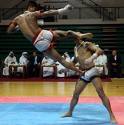|
Muay Boran translates to "Ancient Boxing", is the term
Thai people called their fighting art and competition during the fists
binding or "Kaard Chuerg", to differentiate it from the
modern rules Muay Thai. Eventually, regional styles of Muay Boran were
developed such as Muay Thasao (North), Muay Korat (Eastern or North-East),
Muay Lopburi (Central) and Muay Chaiya (South). |
 |
|
The practice of Muay Boran was
kept up largely by Buddhist monks who were the keepers and teachers of all
arts both practical and spiritual. Temples began holding fights during
festive occasions. As every Thai man is expected to live as a monk at least
once in his life the art grew in popularity among common people, so much so
that it was said that any man worth his salt would practice it.
Muay Boran's form is quite efficient, in that it maximizes the amount of
damage that each blow can inflict, and effective, in that it can easily lead
to the death or serious injury of the opponent. Most notably, Muay Boran
emphasizes the use of extremely powerful elbow and knee techniques, and
combinations thereof, always thrown at full force and speed, with the intent
to overcome one's adversary as quickly as possible, because another one
might already be coming close or attacking. Muay Boran has been influenced
by neighboring martial arts and vice versa such as the Kamae Kham Sao which
is a technique borrowed from Cambodia.
Traditionally, Muay Thai masters would teach the techniques of Muay Boran as
advanced Muay Thai but this is not often done today. Various moves in Muay
Boran are forbidden in present-day Muay Thai tournaments and competitions.
Even in Thailand it is becoming increasingly difficult to find a school
willing to teach it; they prefer to focus on "modern" Muay Thai, as this is
more easily exploitable as a form of income. Many schools nowadays who claim
to offer Muay Boran just teach Muay Thai and sell it under the name of Muay
Boran. |













